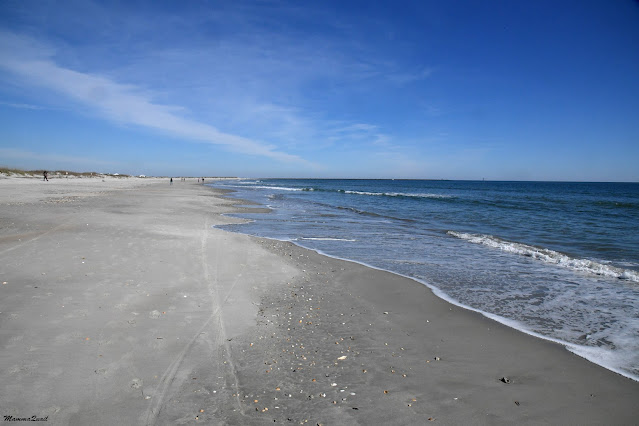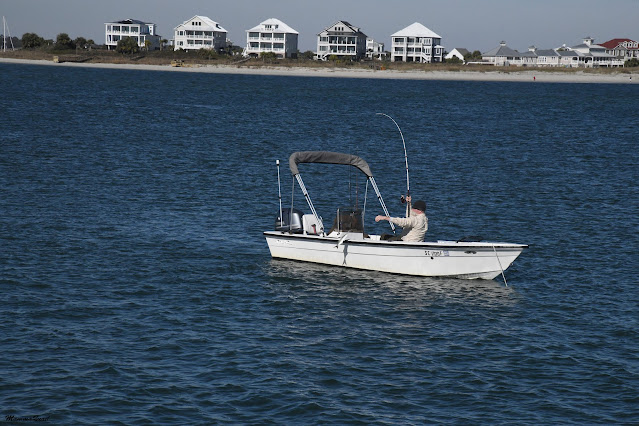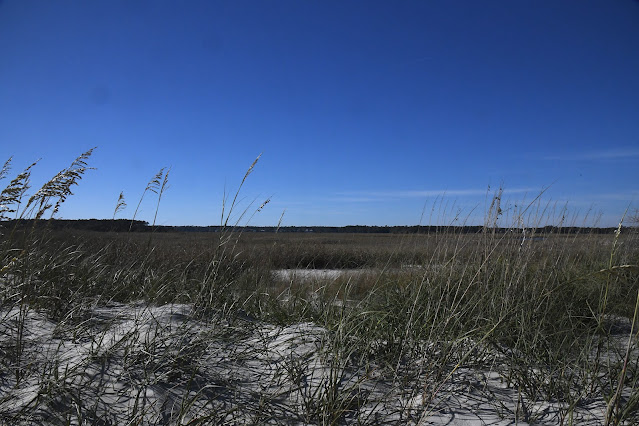 |
| North Murrels Inlet Beach |
Date: November 24, 2024
Place: Huntington Beach State Park, South Carolina
Coordinates: 33.516031, -79.050706
Length: 3.6 miles
Level: easy
Within less than two hours at Huntington Beach State Park we were already rewarded by the richness of fowl life. Hanging by the visitor center's bird feeding station and the short walk we took by the Mullet Pond, yielded many cool sightings, including a number of lifer bird species. I was however, itching for a more serious hike, so after our Mullet Pond birding we followed up on the recommendation of the visitor center staff and drove to the North Murrels Inlet Beach parking lot and trail access.
We had a quick lunch at the picnic area near the parking lot, then gathered our cameras and walked to the beach.
I was a bit surprised to see a dwarf palmetto by the side of the beach access trail. Later I've seen more of them in the more inland part of the park but this was the closest to the ocean that I've seen it grow.
 |
| Dwarf Palmetto, Sabal minor |
Low, partly fixed dunes of white sand welcomed us as we reached the beach. The sand was very fine and soft. I was tempted to take my shoes off but decided that maybe later.
Most of the plants that grew in the sand were tal grasses. My eye was attracted however, to a low vine that reminded me of the sand verbena of the California beaches. I don't think this was a verbena though. One of the things that kept reminding me how far away from home I was, was that I hardly recognised any of the local plants.
straight ahead spread before us the vast Atlantic Ocean. The ocean was very peaceful today and its deep blue color reflected the almost clear blue sky. The sky was mostly clear of clouds, but it wasn't clear of birds.
By family birders (and a few other bird watchers that came to the beach that day) were already engaged in active bird-watching. I joined them and listened to the comments and the discussion.
A few sanderlings scouted the strand line, running out when a wave approached and running back in as the wave receded, sticking their beaks in the soft mud to pluck the little crustaceans that didn't dig themselves quickly enough. Sanderlings are common in California beaches as well, and I always love seeing their beautiful dance with the wave, always done with perfect coordination and precision.
 |
| Sanderlings |
The waves were very small that day, which also surprised me a bit, because the wind was up. I watched the low waves, mesmerized by the foam patterns they created.
 |
| Atlantic Ocean |
Many seashells were strewn along the beach. In this state park, as well as n many others, it is ok to collect shells from the beaches. At first my chikas were picking some to take, but soon they realized there wasn't much they would do with them. By the time we ended the hike most of their collections were returned unceremoniously to the beach.
Birds were flying back and forth along the coastline, most of them if species common also in California, such as the brown pelican. I thought that the Pacific and the Atlantic brown pelicans were of different species, but apparently they are not.
 | |
| Brown Pelican |
A solitary tern scouted the ocean surface from high above but didn't dive down even once, at least not while we were looking.
 |
| Forster's Tern |
The jetty was north of us. we walked slowly in that direction, searching for birds and for other interesting sights. There were very few other people walking along the beach - it looked very spacious and peacefull.
 |
| North Murrels Inlet Beach |
There were few other shorebirds by the strand line other than sanderlings, but not many. A solitary willet had a wide section f the beach completely to itself without competition from other shorebirds.
 |
| Willet |
My chikas found a stranded jellyfish and called me over. It was a large jellyfish and it looked like it was swept ut of the ocean fairly recently. It was still intact and showed no signs of rotting.
I was curious about the various shells I saw on the beach. Many of them looked very different from those I knew from California, but they were familiar to me from what I remembered seeing on the Mediterranean beaches. It wasn't surprising - the Mediterranean Sea is an offshoot of the Atlantic Ocean, but still, it was a long way from South Carolina. An entire ocean away.
Half way to the jetty the beach seemed even more deserted that it looked when we first entered. Even the birds and the birders seemed to have moved away. Pappa Quail shared a mild disappointment about the low bird count, not to mention the lack of new, 'lifer' species. I understood him but really enjoyed the beautiful day at the beach.
 |
| North Murrels Inlet Beach |
The elder chika also wanted t see new bird species, but she was also fascinated by other sights, like the sight of a sanderling taking a bath in the shallows, which she found very amusing.
 |
| Sanderling |
But hen there was excitement - Pappa Quail and the elder chika spotted red knots. They weren't lifers, but these shorebirds they've seen only once before, at Huntington Beach. At Huntington Beach, California, that is.
I couldn't tell a red knot from most other shorebirds, but I was pleased with the sighting - it meant that this hike was a good one, not only for me.
Their next sighting was even more exciting, for this bird was truly a lifer - it was a piping plover. The cute little bird, similar in size and form to the snowy plover of the Pacific coast, was also wearing an ID ring - apparently a rare enough species to be recorded and documented.
The waves were shallow but extended long into the beach sand. Upon retreating, the foam formed beautiful patterns with the little ripples of the retreating water.
Staying behind for a few more seconds after the water had vanished, the foam would linger on the sand, vibrating in the wind, before it too, vanished into the air.
Other things that vanished as soon as the wave retreated were the little sand crustaceans. They's dig themselves quickly into the wet mud. Little bubbling funnel-shaped depressions marked the locations where these strand line critters hid themselves. These were what the shorebirds were after.
I'm not sure a gull is considered a shorebird, but there was a single gull there at the beach, and it too was busy foraging in the shallows.
The terns were not looking for sand dwellers. The scouted the ocean surface from above, looking for fish. I didn't see any tern diving for fish, though.
Sanderlings are definitely shorebirds, and always when I see them, they are in the strand line, searching for the mud critters. This was the first time that I've seen a sanderling interested in eating something else - a dead jellyfish that the ocean had deposited on the shore.
We reached the jetty. I wanted to get to the edge and see what was there, and the rest of my family followed along.
One shorebird was waiting for my family birders on the jetty itself. It was a ruddy turnstone, a species we already knew from California.
The jetty stretched far into the ocean. The water was a little less calm off the shore. The ocean surface was agitated by the wind, but the waves were not high.
Pappa Quail got excited with single duck that was floating in the water near the jetty . He called the elder chika and pointed it out to her. It was a black scotter - a lifer species or my elder chika.
 |
| Black Scoter, female |
I reached the end of the jetty first, and I sat down to drink water and eat a snack. Off the edge of the jetty was a metal tower, the purpose of which I did not know.
As I gazed at the tower, I noticed movement on the rocks at the edge of the jetty. A mongoose-like creature was slinking between the rocks!
My camera didn't have the strong lens on, so I called Pappa Quail. He took his time to come over though - he and the elder chika were busy looking at two northern gannets that cruised the sky far off shore.
Eventually Pappa Quail did come over and he did manage to take a better photo of that animal in the rocks, which turned out to be a lifer for all of us - it was an American mink.
We spend a good half an hour at the end of the jetty, snacking, chatting, and observing the ocean and the beings that we could see from there. We've also seen green turtles, but the best photos of them were taken on our way back down the jetty.
 |
| Green Turtle |
Another, shorter jetty extended out to sea north of the one we were walking on. In the calm water between the two jetties a single fishing boat floated, gently swaying in the low waves.
We were walking the few last yards on the jetty before stepping back down on the sand when we saw a solitary loon swimming between the jetties.
Looking up I noticed a gull flying over. My family birders were focusing on the loon and disregarded the gull, so I took the photo. The gull was holding something in its bill, but it didn't look like a fish. Perhaps it was a piece of human food or trash.
We didn't linger at the base of the jetty, but started right away walking south, back to where we entered the beach.
 |
| North Murrels Inlet Beach |
Sanderlings were perhaps the most common bird that we saw on the beach that day. They owned the strand line space completely, and when we passed by, they barely budged. They are very beautiful and graceful, and I couldn't resist posting one more photo of this lovely bird.
 |
| Sandeling |
We were walking faster now, stopping much less on our way back. Even so, I kept pausing whenever I saw a curiosity. Any irregularity in the regular irregularity of the beached stuff caught my attention, and there were many of them.
 |
| Blue Crab pincer |
Most of the time I walked along the strand line, right between the water and the dry sand. A few time I did walk to the other side, where the dunes rose above the beach and the grasses were fixing the shifting sands.
 |
| North Murrels Inlet Beach |
Between the grasses were also a very few bushes or low trees. On one of them perched a few brown birds.
I didn't come close enough to these birds but my elder chika got a close up photo. At least two of the birds were females of red wing black bird.
 |
| Red-winged Blackbird, females |
I took a few steps up the dune and gazed beyond its crest. There was a flat field of grasses there, and the grasses were swaying in the wind in soft waves. I thought I spotted a pond of open water between the grasses. I didn't see any other birds though. Pappa Quail also scanned the grass field but saw nothing else and went back to the ocean's strand line.
There was another interesting thing by the dune crest - a couple of dead, withered trees that were baring numerous seashells. I tried reading about it - apparently it is a thing in that part of the country to place shells on seaside trees. It might have originated as a charm against evil spirits but I think nowadays it became sort of a collective habit. Either way, it was interesting to see.
We arrived at the place where the beach access trail meets the beach. We were walking for perhaps two hours, but during that time the beach filled with people - at the point of access. Most of the people who came after us were there to have a nice beach day - fishing, kite flying, building sand castles, anything else that make a beach day such fun.
 |
| North Murrels Inlet Beach |
On the way back to the parking lot I noticed another vining plant on the sand. Like the first one, this plant too seemed familiar to me, but I could not recognize what it was or which other plant it reminded me of. None of these plants there were blooming, of course, it was the wrong season for that.
After the beach hike Pappa Quail wanted to revisit the bird feeders at the visitor center, and to do another hike around that area. That other hike turned out to be a short walk in the woods where we didn't get to see much new, but the bird feeder station did turn out a few more birds that we didn't see earlier that day.
Among these other birds was also another lifer species - the tufted titmouse. This made my family birders very happy indeed.
The elder chika has very keen eyes, and she spotted also a rodent in the vegetation below the feeders - a marsh rice rat, which was another lifer species, although not a bird.
Huntington Beach State Park was one of the best nature days of this trip - we got to see a wonderful part of the coastal ecosystem of the Atlantic Ocean, and enjoyed a really lovely day at the beach. We didn't plan hikes for the following day but we did do some more nature exploration - on a river tour boat.




































Very nice and relaxed walk. with many sightings. I think the Mink was the greatest of them...
ReplyDeleteThe mink was a surprise! I didn't expect such an animal to live at the end of a jetty. I loved the turtles most :-)
Delete